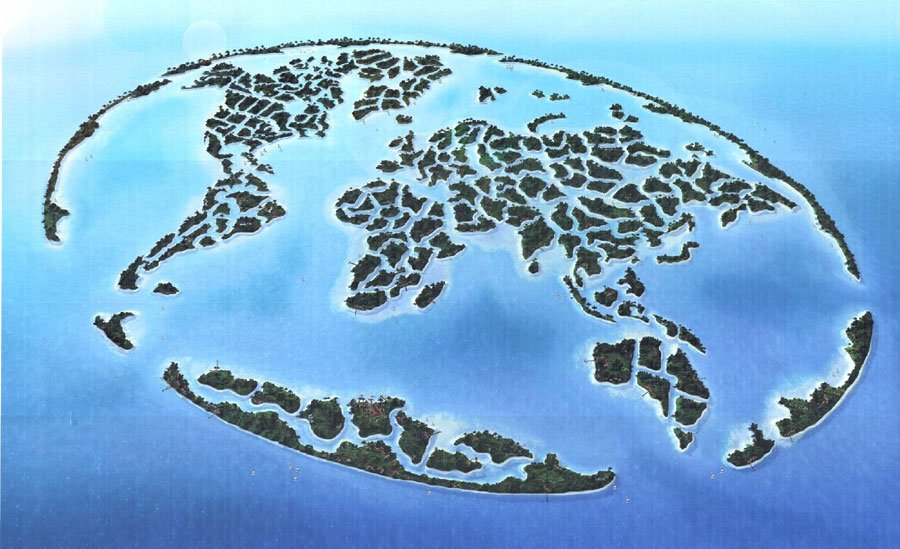By Echo Zhang, in Beijing Jointing.Media 2010-03-14

Due to debt problems, Dubai has halted their World Island construction last November. Lately, the International Space Station has captured series of satellite photos exposing portions of island constructions that show sinking trends. Nature’s response to this event has revealed the winner in the showdown between economic development and environmental protection.
After the Palm Islands artificial island project’s completion, Dubai released a 14-billion-dollar “The World” construction, 300 islands constructed in the rough shape of a map of the landmasses of the Earth in May, 2003. The World is a symbol of rank and honor: each island is 50-100 meters apart; people have to use yachts or helicopters to reach the neighbor island. There are personal vacation housing, fancy hotels and high class shopping malls located on islands; each island even has an individual maritime customs.
The rise of seawater temperature and salt concentration is the main reason for coral reefs’ massive destruction. Human beings’ overdevelopment of the ocean is also exacerbating the oceanic ecology. When dredging has been completed, there will be 321 million cubic meters of sand and 31 million tons of rock in The World Islands. Although these fillers are not artificial or chemical materials, the clear Dubai Gulf is being dragged into sludge due to the construction. Environmental scholars noted that the construction has disturbed the oceanic ecology, drowned the coral reefs, oyster beds and algae. The disrupted food chain and decreasing living space has threatened the existence of local oceanic species. Also, construction has caused disorder of ocean gyres which then erodes the coastlines.
In face of environmentalists’ criticisms, the Dubai government aimed to reduce the impact of the World project by suggesting a post-construction plan, including measures like fostering artificial coral reefs, recovering destroyed coral reef colonies with the help of oceanic specialists and funding related research projects. However, environmental scholars do not have high hopes.
Dubai is one of United Arab Emirates’ seven kingdoms; it accomplished the 50-year process of metropolis development in a matter of ten years. On this small territory, the world’s tallest building arise again and again—from the “seven star” Burj Al Arab Hotel to the newly finished Burj Khalifa. On the basis of developing their high-speed financial and service industry, real estate has become the core source of the “Dubai version” development, filling many pockets of its city managers. Dubai real estate markets do not need pre-sale licenses; all the investors need for starting a construction is to pay 2% of the total construction budget, another 3% for selling the uncompleted sites, and 5% to sell officially. This liberal way of managing real estate as well as overflowing investment money has spiraled up the Dubai real estate market—direct yields are as high as 100%. Ever since the real estate developers have promoted the World, some of its island prices have increased up to 5 times its base price. The purchaser of the “Shanghai island” claims that once people knew islands will have villas built the royal family booked 20 sets in advance while 5 Russians also waved a check around for purchasing a 20-set. People all over the world are rushing to grab a piece of this windfall profit.
Dubai’s economic crisis was main reason for the halt of the World construction. However, behind this unique way of economic expansion, how many people have realized the environment’s needs? Human beings are making profits at the cost of nature’s loss. There might be one day when we are forced to reflect upon our actions but have no more chances to act for a just change.
Translated by Wendy
Edited by Ellen

![[Recruiting 2011] Jointing.Media](http://jointings.org/eng/wp-content/themes/news-magazine-theme-640/cropper.php?src=/cn/wp-content/uploads/2012/06/123.png&h=50&w=50&zc=1&q=95)









